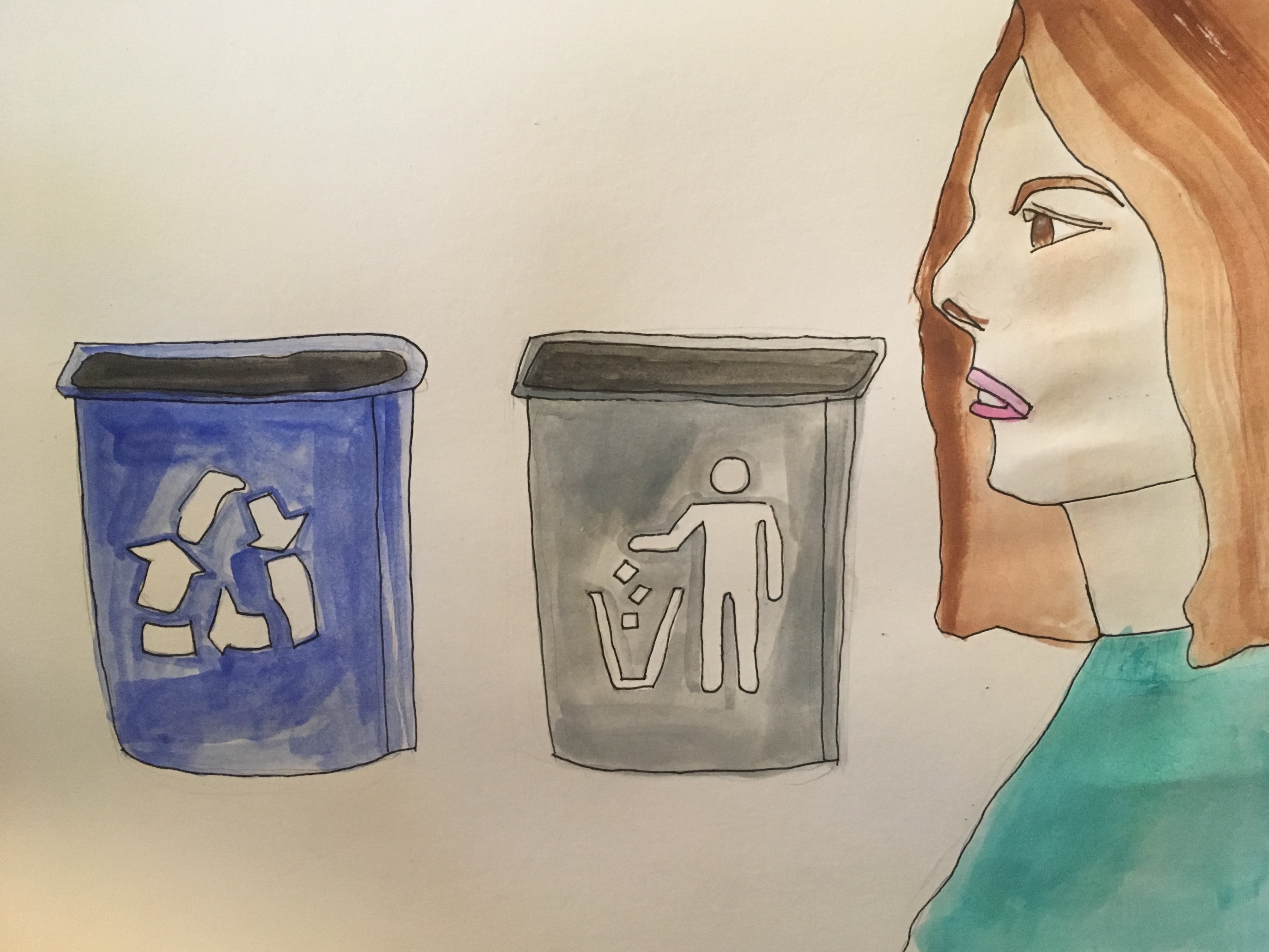Whenever I see a blue recycling bin next to a gray trash bin on this campus, I can’t help but look into the blue bin to see what people have “recycled” in it. Food, candy wrappers, used paper towels—it’s all in there—and it always has me wondering what happens to the refuse in the blue bins.
A common and persistent rumor holds that the custodial staff and grounds crew simply throw everything in the trash, with the blue bins only put out to appease the students. To find the truth to this rumor, I participated in a recycling pick up run with Lynnsie, a longstanding member of the grounds crew here on campus. We rode in a pickup truck and gathered white bags from all around campus before driving them to the transfer station in New London. “Recycling is collected in the white plastic bags, while trash is collected in the gray bags,” Lynnsie said. She also noted that a separate truck would come around later to pick up the gray trash bags.
“We do this all day, five days a week. When one area of campus is clear of white bags, we’ll go to the next one,” said Lynnsie, who has been on the grounds crew for 23 years.
The custodial staff is responsible for gathering the bags from the dorms and putting them outside for collection, so the timing and frequency of pickup varies from building to building. “When there is trash in the recycling bins, the custodians don’t have the time to separate it so they’ll just tie it off and leave it,” said Lynnsie, who stresses that it is up to the students to recycle the right items. “You can’t recycle used paper towels because they have already been recycled once. They can’t go through again.”
After being collected on campus, all waste is brought to the New London transfer station, and after some time is sent to the plant in Preston, Connecticut, where recyclables are sorted and sent to the respective facilities for recycling. Trash is incinerated. “We don’t do any sorting here,” says Quincy, an employee of the transfer station, “we send it up to Preston in eighteen wheelers and they process everything there.”
Organic refuse, such as grass clippings and leaves, are collected by the College grounds crew and brought to the end of Benham Ave. where they are put in a large compost pile, and then used for planting on campus. Tree limbs and fallen trees are chipped and used as mulch. “Broken dorm furniture too. Your broken desk from last year could be the mulch in front of your dorm this year,” said Lynnsie, also noting that the school spends no money on mulch or mulch servicing because of this policy.
When asked where the biggest problems lie with recycling at Conn, Lynnsie responded immediately. “The Ridge is terrible. They just throw the stuff in the barrels and don’t bag it, it’s all jumbled in there. If it’s not bagged, we can’t collect it as recycling so it all goes into trash. The Ridges and Winchesters need to bag their recycling; we don’t have the time to do it for you.” Grounds has a truck with a bin tipper for trash, meaning non-bagged trash can be mechanically dumped into the truck, but the recycling truck lacks a tipper, so staff members have to lift all of the recycling bags and put them in the truck manually. Lynnsie added that the academic buildings are the best at recycling, and some dorms are better than others, but that it mostly comes down to differences in custodial staff.
While collecting recycling at Smith house, I noticed one bag was much heavier than the others. A quick look inside revealed that it was full of food waste. “Bags like this, that are full of non-recyclable materials, we have to leave for trash,” Lynnsie said, “they can’t sort through this at the plant, so even if there are recyclables in this bag, they get thrown in the incinerator.”
Lynnsie and I agreed that it is not helpful for students to recycle trash items, and this practice is a hindrance to the grounds crew and the workers at the recycling facility. “What you put in a recycling bin doesn’t magically become recycling. You need to know what you’re putting in there,” Lynnsie observed. Lynnsie advocates for more education on what and what not to recycle by putting up more posters with lists of recyclable materials.
Despite all of this, Lynnsie thinks that recycling has improved on campus in recent years. “The amount [of recycled material] has definitely increased. It varies from class to class, but it has been increasing steadily these past couple years, and more education will hopefully increase it even more.” She pointed to the give-and-go stations, put up at the end of the year for students to leave unwanted items, as an example of a positive trend for the College. “That’s where we get our overtime, when you guys move in and out. A lot of that stuff goes to New London families after the students are done picking it over.”
To further improve recycling on campus, Lynnsie again asked for students in the Village to bag their recyclables. “It’s a pain for us to deal with loose trash in the barrels, and most of the stuff is bottles and cans and cardboard, which can all be recycled instead of thrown away,” she said. She also asked students to watch what they put in recycling bins, and to make sure it is actually recyclable. It is up to the student body to improve the state of recycling here at Conn.









